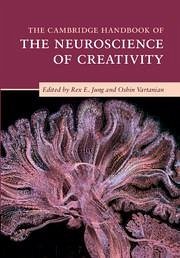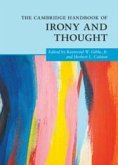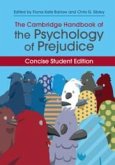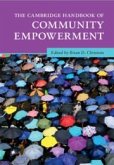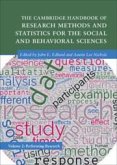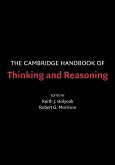The Cambridge Handbook of the Neuroscience of Creativity
Herausgeber: Jung, Rex E; Vartanian, Oshin
The Cambridge Handbook of the Neuroscience of Creativity
Herausgeber: Jung, Rex E; Vartanian, Oshin
- Gebundenes Buch
- Merkliste
- Auf die Merkliste
- Bewerten Bewerten
- Teilen
- Produkt teilen
- Produkterinnerung
- Produkterinnerung
This volume represents the most authoritative overview of how the brain gives rise to creativity in all of its many forms.
Andere Kunden interessierten sich auch für
![The Cambridge Handbook of Consciousness The Cambridge Handbook of Consciousness]() Philip David Zelazo / Morris Moscovitch / Evan Thompson (eds.)The Cambridge Handbook of Consciousness190,99 €
Philip David Zelazo / Morris Moscovitch / Evan Thompson (eds.)The Cambridge Handbook of Consciousness190,99 €![The Cambridge Handbook of Irony and Thought The Cambridge Handbook of Irony and Thought]() The Cambridge Handbook of Irony and Thought191,99 €
The Cambridge Handbook of Irony and Thought191,99 €![The Cambridge Handbook of the Psychology of Prejudice The Cambridge Handbook of the Psychology of Prejudice]() The Cambridge Handbook of the Psychology of Prejudice109,99 €
The Cambridge Handbook of the Psychology of Prejudice109,99 €![The Cambridge Handbook of Community Empowerment The Cambridge Handbook of Community Empowerment]() The Cambridge Handbook of Community Empowerment191,99 €
The Cambridge Handbook of Community Empowerment191,99 €![The Cambridge Handbook of Research Methods and Statistics for the Social and Behavioral Sciences The Cambridge Handbook of Research Methods and Statistics for the Social and Behavioral Sciences]() The Cambridge Handbook of Research Methods and Statistics for the Social and Behavioral Sciences166,99 €
The Cambridge Handbook of Research Methods and Statistics for the Social and Behavioral Sciences166,99 €![The Cambridge Handbook of Violent Behavior and Aggression The Cambridge Handbook of Violent Behavior and Aggression]() The Cambridge Handbook of Violent Behavior and Aggression215,99 €
The Cambridge Handbook of Violent Behavior and Aggression215,99 €![The Cambridge Handbook of Thinking and Reasoning The Cambridge Handbook of Thinking and Reasoning]() Keith J. Holyoak / Robert G. Morrison (eds.)The Cambridge Handbook of Thinking and Reasoning69,99 €
Keith J. Holyoak / Robert G. Morrison (eds.)The Cambridge Handbook of Thinking and Reasoning69,99 €-
-
-
This volume represents the most authoritative overview of how the brain gives rise to creativity in all of its many forms.
Produktdetails
- Produktdetails
- Verlag: Cambridge University Press
- Seitenzahl: 566
- Erscheinungstermin: 25. Januar 2018
- Englisch
- Abmessung: 259mm x 179mm x 38mm
- Gewicht: 1692g
- ISBN-13: 9781107147614
- ISBN-10: 1107147611
- Artikelnr.: 48686050
- Herstellerkennzeichnung
- Libri GmbH
- Europaallee 1
- 36244 Bad Hersfeld
- gpsr@libri.de
- Verlag: Cambridge University Press
- Seitenzahl: 566
- Erscheinungstermin: 25. Januar 2018
- Englisch
- Abmessung: 259mm x 179mm x 38mm
- Gewicht: 1692g
- ISBN-13: 9781107147614
- ISBN-10: 1107147611
- Artikelnr.: 48686050
- Herstellerkennzeichnung
- Libri GmbH
- Europaallee 1
- 36244 Bad Hersfeld
- gpsr@libri.de
Introduction Rex E. Jung and Oshin Vartanian; Part I. Fundamental Concepts:
1. Creative ideas and the creative process: good news and bad news for the
neuroscience of creativity Dean Keith Simonton; 2. Homeostasis and the
control of creative drive Alice W. Flaherty; 3. Laterality and creativity:
a false trail? Michael C. Corballis; 4. The neural basis and evolution of
divergent and convergent thought Liane Gabora; Part II. Pharmacology and
Psychopathology: 5. Stress, pharmacology, and creativity David Q.
Beversdorf; 6. Functional neuroimaging of psychedelic experience: an
overview of psychological and neural effects and their relevance to
research on creativity, daydreaming, and dreaming Kieran C. R. Fox, Cameron
C. Parro and Kalina Christoff; 7. A heated debate: time to address the
underpinnings of the association between creativity and psychopathology?
Simon Kyaga; 8. Creativity and psychopathology: a relationship of shared
neurocognitive vulnerabilities Shelley H. Carson; Part III. Attention and
Imagination: 9. Attention and creativity Darya L. Zabelina; 10. Internally
directed attention in creative cognition Mathias Benedek; 11. The forest
versus the trees: creativity, cognition and imagination Anna Abraham; 12. A
common mode of processing governing divergent thinking and future
imagination Reece P. Roberts and Donna Rose Addis; Part IV. Memory and
Language: 13. Going the extra creative mile: the role of semantic distance
in creativity theory, research, and measurement Yoed N. Kenett; 14.
Episodic memory and cognitive control: contributions to creative idea
production Roger E. Beaty and Daniel L. Schacter; 15. Free association,
divergent thinking and creativity: cognitive and neural perspectives Tali
Marron and Miriam Faust; 16. Figurative language comprehension and
laterality in Autism Spectrum Disorder Ronit Saban-Bezalel and Nira Mashal;
Part V. Cognitive Control and Executive Functions: 17. The costs and
benefits of cognitive control for creativity Evangelia G. Chrysikou; 18.
Creativity and cognitive control in the cognitive and affective domains
Andreas Fink, Corinna Perchtold and Christian Rominger; 19. Associative and
controlled cognition in divergent thinking: theoretical, experimental,
neuroimaging evidence, and new directions Emmanuelle Volle; Part VI.
Reasoning and Intelligence: 20. Creativity in the distance: the
neurocognition of semantically distant relational thinking and reasoning
Adam Green; 21. Network dynamics theory of human intelligence Aki
Nikolaidis and Aron K. Barbey; 22. Training to be creative: the interplay
between cognition, skill learning, and motivation Indre V. Viskontas; 23.
Intelligence and creativity from the neuroscience perspective Emanuel Jauk;
Part VII. Individual Differences: 24. The genetics of creativity: the
underdog of behavior genetics? Davide Piffer; 25. Structural studies of
creativity measured by divergent thinking Hikaru Takeuchi and Ryuta
Kawashima; 26. Openness to experience: insights from personality
neuroscience Oshin Vartanian; 27. Creativity and the aging brain Kenneth M.
Heilman and Ira S. Fleischer; Part VIII. Artistic and Eesthetic Processes:
28. The neuroscience of musical creativity David Bashwiner; 29. Artistic
and aesthetic production: progress and limitations Malinda J. McPherson;
30. Polymathy: the resurrection of renaissance man and the renaissance
brain Claudia Garcia-Vega and Vincent Walsh.
1. Creative ideas and the creative process: good news and bad news for the
neuroscience of creativity Dean Keith Simonton; 2. Homeostasis and the
control of creative drive Alice W. Flaherty; 3. Laterality and creativity:
a false trail? Michael C. Corballis; 4. The neural basis and evolution of
divergent and convergent thought Liane Gabora; Part II. Pharmacology and
Psychopathology: 5. Stress, pharmacology, and creativity David Q.
Beversdorf; 6. Functional neuroimaging of psychedelic experience: an
overview of psychological and neural effects and their relevance to
research on creativity, daydreaming, and dreaming Kieran C. R. Fox, Cameron
C. Parro and Kalina Christoff; 7. A heated debate: time to address the
underpinnings of the association between creativity and psychopathology?
Simon Kyaga; 8. Creativity and psychopathology: a relationship of shared
neurocognitive vulnerabilities Shelley H. Carson; Part III. Attention and
Imagination: 9. Attention and creativity Darya L. Zabelina; 10. Internally
directed attention in creative cognition Mathias Benedek; 11. The forest
versus the trees: creativity, cognition and imagination Anna Abraham; 12. A
common mode of processing governing divergent thinking and future
imagination Reece P. Roberts and Donna Rose Addis; Part IV. Memory and
Language: 13. Going the extra creative mile: the role of semantic distance
in creativity theory, research, and measurement Yoed N. Kenett; 14.
Episodic memory and cognitive control: contributions to creative idea
production Roger E. Beaty and Daniel L. Schacter; 15. Free association,
divergent thinking and creativity: cognitive and neural perspectives Tali
Marron and Miriam Faust; 16. Figurative language comprehension and
laterality in Autism Spectrum Disorder Ronit Saban-Bezalel and Nira Mashal;
Part V. Cognitive Control and Executive Functions: 17. The costs and
benefits of cognitive control for creativity Evangelia G. Chrysikou; 18.
Creativity and cognitive control in the cognitive and affective domains
Andreas Fink, Corinna Perchtold and Christian Rominger; 19. Associative and
controlled cognition in divergent thinking: theoretical, experimental,
neuroimaging evidence, and new directions Emmanuelle Volle; Part VI.
Reasoning and Intelligence: 20. Creativity in the distance: the
neurocognition of semantically distant relational thinking and reasoning
Adam Green; 21. Network dynamics theory of human intelligence Aki
Nikolaidis and Aron K. Barbey; 22. Training to be creative: the interplay
between cognition, skill learning, and motivation Indre V. Viskontas; 23.
Intelligence and creativity from the neuroscience perspective Emanuel Jauk;
Part VII. Individual Differences: 24. The genetics of creativity: the
underdog of behavior genetics? Davide Piffer; 25. Structural studies of
creativity measured by divergent thinking Hikaru Takeuchi and Ryuta
Kawashima; 26. Openness to experience: insights from personality
neuroscience Oshin Vartanian; 27. Creativity and the aging brain Kenneth M.
Heilman and Ira S. Fleischer; Part VIII. Artistic and Eesthetic Processes:
28. The neuroscience of musical creativity David Bashwiner; 29. Artistic
and aesthetic production: progress and limitations Malinda J. McPherson;
30. Polymathy: the resurrection of renaissance man and the renaissance
brain Claudia Garcia-Vega and Vincent Walsh.
Introduction Rex E. Jung and Oshin Vartanian; Part I. Fundamental Concepts:
1. Creative ideas and the creative process: good news and bad news for the
neuroscience of creativity Dean Keith Simonton; 2. Homeostasis and the
control of creative drive Alice W. Flaherty; 3. Laterality and creativity:
a false trail? Michael C. Corballis; 4. The neural basis and evolution of
divergent and convergent thought Liane Gabora; Part II. Pharmacology and
Psychopathology: 5. Stress, pharmacology, and creativity David Q.
Beversdorf; 6. Functional neuroimaging of psychedelic experience: an
overview of psychological and neural effects and their relevance to
research on creativity, daydreaming, and dreaming Kieran C. R. Fox, Cameron
C. Parro and Kalina Christoff; 7. A heated debate: time to address the
underpinnings of the association between creativity and psychopathology?
Simon Kyaga; 8. Creativity and psychopathology: a relationship of shared
neurocognitive vulnerabilities Shelley H. Carson; Part III. Attention and
Imagination: 9. Attention and creativity Darya L. Zabelina; 10. Internally
directed attention in creative cognition Mathias Benedek; 11. The forest
versus the trees: creativity, cognition and imagination Anna Abraham; 12. A
common mode of processing governing divergent thinking and future
imagination Reece P. Roberts and Donna Rose Addis; Part IV. Memory and
Language: 13. Going the extra creative mile: the role of semantic distance
in creativity theory, research, and measurement Yoed N. Kenett; 14.
Episodic memory and cognitive control: contributions to creative idea
production Roger E. Beaty and Daniel L. Schacter; 15. Free association,
divergent thinking and creativity: cognitive and neural perspectives Tali
Marron and Miriam Faust; 16. Figurative language comprehension and
laterality in Autism Spectrum Disorder Ronit Saban-Bezalel and Nira Mashal;
Part V. Cognitive Control and Executive Functions: 17. The costs and
benefits of cognitive control for creativity Evangelia G. Chrysikou; 18.
Creativity and cognitive control in the cognitive and affective domains
Andreas Fink, Corinna Perchtold and Christian Rominger; 19. Associative and
controlled cognition in divergent thinking: theoretical, experimental,
neuroimaging evidence, and new directions Emmanuelle Volle; Part VI.
Reasoning and Intelligence: 20. Creativity in the distance: the
neurocognition of semantically distant relational thinking and reasoning
Adam Green; 21. Network dynamics theory of human intelligence Aki
Nikolaidis and Aron K. Barbey; 22. Training to be creative: the interplay
between cognition, skill learning, and motivation Indre V. Viskontas; 23.
Intelligence and creativity from the neuroscience perspective Emanuel Jauk;
Part VII. Individual Differences: 24. The genetics of creativity: the
underdog of behavior genetics? Davide Piffer; 25. Structural studies of
creativity measured by divergent thinking Hikaru Takeuchi and Ryuta
Kawashima; 26. Openness to experience: insights from personality
neuroscience Oshin Vartanian; 27. Creativity and the aging brain Kenneth M.
Heilman and Ira S. Fleischer; Part VIII. Artistic and Eesthetic Processes:
28. The neuroscience of musical creativity David Bashwiner; 29. Artistic
and aesthetic production: progress and limitations Malinda J. McPherson;
30. Polymathy: the resurrection of renaissance man and the renaissance
brain Claudia Garcia-Vega and Vincent Walsh.
1. Creative ideas and the creative process: good news and bad news for the
neuroscience of creativity Dean Keith Simonton; 2. Homeostasis and the
control of creative drive Alice W. Flaherty; 3. Laterality and creativity:
a false trail? Michael C. Corballis; 4. The neural basis and evolution of
divergent and convergent thought Liane Gabora; Part II. Pharmacology and
Psychopathology: 5. Stress, pharmacology, and creativity David Q.
Beversdorf; 6. Functional neuroimaging of psychedelic experience: an
overview of psychological and neural effects and their relevance to
research on creativity, daydreaming, and dreaming Kieran C. R. Fox, Cameron
C. Parro and Kalina Christoff; 7. A heated debate: time to address the
underpinnings of the association between creativity and psychopathology?
Simon Kyaga; 8. Creativity and psychopathology: a relationship of shared
neurocognitive vulnerabilities Shelley H. Carson; Part III. Attention and
Imagination: 9. Attention and creativity Darya L. Zabelina; 10. Internally
directed attention in creative cognition Mathias Benedek; 11. The forest
versus the trees: creativity, cognition and imagination Anna Abraham; 12. A
common mode of processing governing divergent thinking and future
imagination Reece P. Roberts and Donna Rose Addis; Part IV. Memory and
Language: 13. Going the extra creative mile: the role of semantic distance
in creativity theory, research, and measurement Yoed N. Kenett; 14.
Episodic memory and cognitive control: contributions to creative idea
production Roger E. Beaty and Daniel L. Schacter; 15. Free association,
divergent thinking and creativity: cognitive and neural perspectives Tali
Marron and Miriam Faust; 16. Figurative language comprehension and
laterality in Autism Spectrum Disorder Ronit Saban-Bezalel and Nira Mashal;
Part V. Cognitive Control and Executive Functions: 17. The costs and
benefits of cognitive control for creativity Evangelia G. Chrysikou; 18.
Creativity and cognitive control in the cognitive and affective domains
Andreas Fink, Corinna Perchtold and Christian Rominger; 19. Associative and
controlled cognition in divergent thinking: theoretical, experimental,
neuroimaging evidence, and new directions Emmanuelle Volle; Part VI.
Reasoning and Intelligence: 20. Creativity in the distance: the
neurocognition of semantically distant relational thinking and reasoning
Adam Green; 21. Network dynamics theory of human intelligence Aki
Nikolaidis and Aron K. Barbey; 22. Training to be creative: the interplay
between cognition, skill learning, and motivation Indre V. Viskontas; 23.
Intelligence and creativity from the neuroscience perspective Emanuel Jauk;
Part VII. Individual Differences: 24. The genetics of creativity: the
underdog of behavior genetics? Davide Piffer; 25. Structural studies of
creativity measured by divergent thinking Hikaru Takeuchi and Ryuta
Kawashima; 26. Openness to experience: insights from personality
neuroscience Oshin Vartanian; 27. Creativity and the aging brain Kenneth M.
Heilman and Ira S. Fleischer; Part VIII. Artistic and Eesthetic Processes:
28. The neuroscience of musical creativity David Bashwiner; 29. Artistic
and aesthetic production: progress and limitations Malinda J. McPherson;
30. Polymathy: the resurrection of renaissance man and the renaissance
brain Claudia Garcia-Vega and Vincent Walsh.

